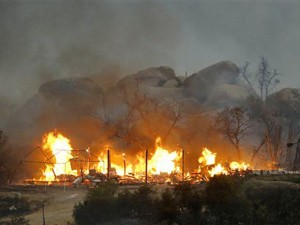Radio problems cited in deaths of 19 firefighters

In this Sunday, June 30, 2013, file photo, the Yarnell Hill Fire burns in Glenn Ilah near Yarnell, Ariz. Investigators are set to release a report Saturday, Sept. 28, 2013, on the deaths of 19 elite firefighters in Arizona, nearly three months after the crew became trapped by flames in a brush-choked canyon north of Phoenix. AP
PRESCOTT, Arizona — A three-month investigation into the June deaths of 19 firefighters killed while battling an Arizona blaze cites poor communication between the men and support staff, and reveals that an airtanker carrying flame retardant was hovering overhead as the firefighters died.
The 120-page report released Saturday found that proper procedure was followed and assigned little blame for the worst firefighting tragedy since the terrorist attacks of Sept. 11, 2001.
All but one member of the Granite Mountain Hotshots crew died June 30 while protecting the small former gold rush town of Yarnell, about 80 miles (130 kilometers) northwest of Phoenix, from an erratic, lightning-sparked wildfire.
While maintaining a neutral tone, the investigation found badly programmed radios, vague updates, and a 33-minute communication blackout just before the flames engulfed the men. Investigators did not consider whether better communication might have saved the men. Hotshots are highly trained backcountry firefighters who hike deep into the brush to fight blazes.
While maintaining a neutral tone, the investigation cited badly programmed radios, vague updates, and a 33-minute communication blackout just before the flames engulfed the men. Though the report points to multiple failures, investigators did not consider whether the deaths could have been avoided, raising questions about what lessons firefighters can take from the tragedy.
Article continues after this advertisement“These guys were doing what they were trained to do, and doing it well. But mother nature wins,” Jeff Berino, an incident commander in Colorado who has also worked as a fire investigator, said during a media briefing in Prescott, where all of the fallen firefighters lived.
Article continues after this advertisementSome family members were angered that the report didn’t draw stronger conclusions about why the men died and recommend changes. David Turbyfill interrupted the news conference to shame officials for not providing his 27-year-old son Travis with the protection he needed to survive as the flames swept over him. He said the shelter Travis died in had not been improved in 13 years.
“This report is fairly conclusive that the fire shelters are a total disaster. Policies, as they may be, need to change,” Turbyfill said.
His wife, Shari, begged the panel to move more quickly to correct the problems that contributed to her stepson’s death.
“Your protection of us is killing us,” she said. “We’re willing to take the heat right now, but I don’t want another family to deal with this. Help us, I implore you. Help us. Give us the information we need to change this. It is so necessary, please.”
The report, produced by a team of local, state and federal fire experts, provides the first minute-to-minute account of the fatal afternoon. The day went according to routine in the boulder-strewn mountains until the wind shifted around 4 p.m., pushing a wall of fire that had been receding from the firefighters all day back toward them.
After that, the command center lost track of the 19 men. Without telling command, and despite the weather warning, the firefighters left the safety of a burned ridge and dropped into a densely vegetated basin surrounded by mountains on three sides. Investigators noted that the men failed to perceive the “excessive risk” of this move and said there was no way to know why the firefighters made the deadly decision. The command center believed the firefighters had decided to wait out the weather change in the safety zone.
Command did not find out the men were surrounded by flames and fighting for their lives until five minutes before they deployed their emergency shelters, which was more than a half hour after the weather warning was issued.
Without guidance from headquarters or their lookout, who had left after warning the crew, the men had gone into a canyon that soon turned into a bowl of fire. The topography whipped up 70-foot (21-meter) flames that bent parallel and licked the ground, producing 2,000 degree Fahrenheit (1,093 degree Celsius). Fire shelters, always a dreaded last resort, start to melt at 1,200 degrees F (649 C).
As the flames overcame the men, a large air tanker was hovering above, trying to determine their location.
The firefighters may have failed to communicate during that crucial half hour because they entered a dead zone, or because they were wary of overloading the radio channels. In the end, the same communication gaps that stymied the rescue effort hindered the reconstruction of the tragedy.
“Nobody will ever know how the crew actually saw their situation, the options they considered or what motivated their actions,” investigators wrote.
They recommended that Arizona officials review their communications procedures and look into new technologies, including GPS, that might help track firefighters during chaotic situations.
When it began June 28, the fire caused little immediate concern because of its remote location and small size. But the blaze quickly grew into an inferno, burning swiftly across pine, juniper and scrub oak and through an area that hadn’t experienced a significant wildfire in nearly 50 years.
The fire ended up destroying more than 100 homes and burned 13 square miles before it was fully contained on July 10.
No other wildfire had claimed the lives of more firefighters in 80 years, and it was the deadliest single day for fire crews since the terror attacks of Sept. 11, 2001.